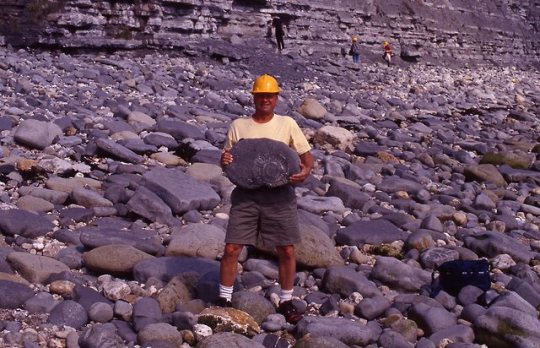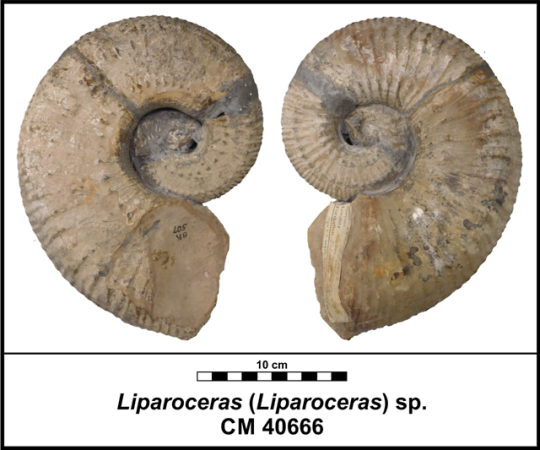My position as a Research Volunteer in the Section of Invertebrate Paleontology (IP) allows me to delve into stories about the collection that I find interesting. One of my research assignments is to investigate the fossils from Lyme Regis, England. The Lyme Regis fossils are part of the 130,000 specimens purchased by Andrew Carnegie from the Baron de Bayet of Belgium in 1903. Some of the Bayet fossils are incorporated into the museum’s Dinosaurs in Their Time (DITT) in the Triassic, Jurassic, Cretaceous, and a special Lyme Regis case that showcases 13 invertebrate and vertebrate fossils.
The village of Lyme Regis is situated on the Dorset Coast, and as such, receives some of the worst weather associated with the English Channel. The Lyme Regis cliffs and beaches have been a fossil hunting graveyard for two hundred years, first made famous by resident Mary Anning (1799 – 1847). When she was just twelve years old she found a large skeleton of a marine reptile known as an Ichthyosaur (literally “fish lizard”). Ichthyosaurs were predators that fed on Jurassic fishes and ammonites. It’s easy to see how she developed a love of fossils after discovering such a magnificent creature as a child. For years, she amassed collections of plesiosaurs, pterosaurs, fish skeletons, and other marine fossils and sold them for a living to paleontologists worldwide. In DITT, there are two examples of Ichthyosaur specimens, a skull (CM 877) and a three-foot-long skeleton (CM 23822). Unfortunately, Mary Anning was not recognized during her life for her accomplishments, probably because she was not a trained paleontologist and she was female. After her death, the collections became widely known to the scientific community, bringing about a better understanding of the paleontology of the Dorset coast.
A fascinating piece of trivia about Lyme Regis is the filming of the 1980 movie, The French Lieutenant’s Women, which depicts the lead male actor, Jeremy Irons, using a simple rock hammer to extract a fossil ammonite from the cliff. If only it was that easy to collect from the 300-meter sheer cliff. My supervisor, Albert Kollar, collected fossils along the Lyme Regis beach in 1999. He opined “most fossils are eroded naturally because of the storm waves coming in from the English Channel that eat away at the rock each year, collapsing to the beach in broken blocks that eventually expose the fossils over time.”

My project was to research the Lyme Regis mollusks i.e., ammonites, nautiloids, and belemnites, update their identification, and review the climate aspects of the Jurassic sea that once covered this part of Europe approximately 199 to 190 million years ago. Paleontologists use marine fossils to interpret past paleoclimates and the paleoenvironments in which the animals once lived. The Jurassic is commonly considered as an interval of sustained warmth without any well-documented glacial deposits at the polar regions. The Lyme Regis fossils are preserved in very discrete layers of limestone strata often named “Lias” by European geologists. The terminology used today is early Jurassic Sinemurian Stage. The fossil mollusks are singular specimen’s that measure approximately 1 inch to 8 inches in diameter. The Carnegie of Natural History collection contains 16 invertebrate specimens from the genera Acanthoteuthis, Asteroceras, Eoderoceras, Liparoceras, Lytoceras, Microderoceras, Nautilus, Radstockiceras, and Xipheroceras.
All Bayet fossils were recorded in the Carnegie Museum Catalog of Fossils. The Cephalopod Catalog contains ammonite, nautiloid, and belemnoid fossils assigned by Bayet and includes details such as collection localities and stratigraphic horizon. Some Lyme Regis specimens are recognized by having two letters “BK” and a painted number, as seen on CM 40666. In 1975, a Swiss paleontologist, Dr. Felix Wiedenmayer, was on a research sabbatical to study fossil sponges at the Carnegie Museum, as well as an expert on Mesozoic ammonites from Europe. He reviewed many Mesozoic ammonites providing updated identification to genus and species, and stratigraphic horizon data, including some of the Lyme Regis ammonite fossils.

To complete the project, I created a virtual geology, paleontology, and exhibit folder in PowerPoint. This includes photographs of the specimens, a geologic map of Lyme Regis and the Dorset Coast, a Paleogeographic map, the distribution of genus and species in the collection, and references. The photographs in this study were taken by IP Research Associate/volunteer John Harper.
I have had a great experience at the Carnegie Museum of Natural History gaining knowledge about these fossil collections, stratigraphy, and geologic time. Now, I look forward to graduate school in part to study microfossils that lived in the seas during a climate “event” around 56 million years ago during the Paleogene Epoch. This event is called the “Paleocene-Eocene Thermal Maximum” (PETM), and is so named because it demarcates the boundary between these two epochs of geologic time. It has been a pleasure looking at these exceptional cephalopods at the Carnegie Museum, and I look forward to any more potential collaborations in the future.
William Vincett is a research volunteer in the Section of Invertebrate Paleontology and a graduate student at the University of Delaware. Museum employees and volunteers are encouraged to blog about their unique experiences and knowledge gained from working at the museum.
